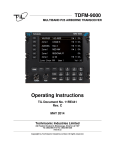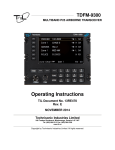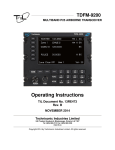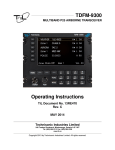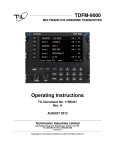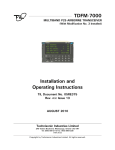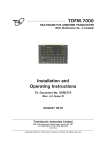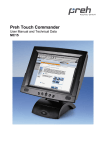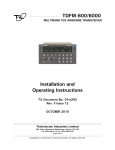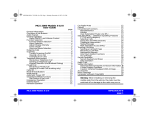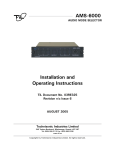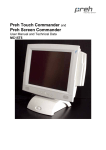Download TDFM-9100 Operating Instructions
Transcript
TDFM-9100 MULTIBAND P25 AIRBORNE TRANSCEIVER Operating Instructions TiL Document No. 13RE482 Rev. N/C November 2014 Technisonic Industries Limited 240 Traders Boulevard, Mississauga, Ontario L4Z 1W7 Tel: (905) 890-2113 Fax: (905) 890-5338 www.til.ca Copyright 2012 by Technisonic Industries Limited. All rights reserved. ii REVISION HISTORY [ 13RE482 ] REV SECTION - PAGE - DESCRIPTION iii DATE Edited by iv NOTES CAUTION STATIC SENSITIVE ! This unit contains static sensitive devices. Wear a grounded wrist strap and/or conductive gloves when handling printed circuit boards. FCC COMPLIANCE INFORMATION This device complies with Part 15 of the FCC Rules. Operation is subject to the following two conditions: (1) this device may not cause harmful interference and (2) this device must accept any interference received, including interference that may cause undesired operation. WARNING: For compliance with FCC RF Exposure Requirements the mobile transmitter antenna installation shall comply with the following two conditions: 1. The transmitter antenna gain shall not exceed 3 dBi. 2. The transmitter antennas shall be located outside of a vehicle and must not be co-located (kept at a separation distance of more than 20cm from each other when installed). Also they must be installed in such a way that they always maintain a separation distance of more than 90cm from any person during operation. NOTE: This equipment has been tested and found to comply with the limits for a Class A digital device, pursuant to Part 15 of the FCC Rules. These limits are designed to provide reasonable protection against harmful interference when the equipment is operated in a commercial environment. This equipment generates, uses, and can radiate radio frequency energy and, if not installed and used in accordance with the instruction manual, may cause harmful interference to radio communications. Operation of this equipment in a residential area is likely to cause harmful interference, in which case the user will be required to correct the interference at his/her own expense. WARNING AND DISCLAIMER Changes or modifications not expressly approved by Technisonic Industries could void the user’s authority to operate the equipment. This manual is designed to provide information about the TDFM-9100. Every effort has been made to make this manual as complete and accurate as possible. WARRANTY INFORMATION The Model TDFM-9000 Transceiver is under warranty for one year from date of purchase. Failed units caused by defective parts, or workmanship should be returned to: Technisonic Industries Limited 240 Traders Boulevard Mississauga, Ontario L4Z 1W7 Tel: (905) 890-2113 Fax: (905) 890-5338 TDFM-9100 Operating Instructions TiL 13RE482 rev N/C v SUMMARY OF DO-160G ENVIRONMENTAL TESTING Summary of DO-160G Environmental Testing for Technisonic Model TDFM-9100 Transceiver: Conditions Category Temperature and Altitude A2, B1, C4, D1 Temperature Variation B Humidity A Operational shock and Crash Safety A Vibration S, U Magnetic Effect Z Power Input B Voltage Spike B Audio Frequency Susceptibility B Induced Signal Susceptibility AC Radio Frequency Susceptibility T Radio Frequency Emission M Electrostatic Discharge A STC APPROVAL NOTE Presently, no TSO standard exists for airborne FM transceivers. To make it easier for installation agencies to provide their customers with an approved installation supported by an effective Airworthiness Approval, Technisonic has secured Supplemental Type Certificate (STC) Approvals on its Airborne FM products for a limited number of airframes. The above referenced DO-160G test data is also on file and available from Technisonic to support approval requirements in airframes for which Technisonic does not possess an STC. Approved aircraft types are listed in the attachments to the formal STC documents. These STCs are the exclusive property of Technisonic and require the written authority of Technisonic for their use. Letters of permissin are provided upon request. To assist Factory Authorized Technisonic Dealers in the certification process, we have placed copies of our STCs on our web site. These documents may be downloaded and used as support for the technical submission to FAA or Transport Canada. Only authorized factory dealers/installers are permitted to download and make use of these documents on behalf of their customers (end users) in support of regulatory agency approval. Please refer to the Technisonic web site www.til.ca for the latest issue of available STCs. WARNING AND DISCLAIMER This manual is designed to provide information about the TDFM-9100. Every effort has been made to make this manual as complete and accurate as possible. TRADEMARK NOTICES TDFM-9100 Transceivers contain two-way radio protocols licensed from Motorola, Inc. © 1997, 1998 Motorola, Inc. TDFM-9100 Operating Instructions TiL 13RE482 rev N/C vi TECHNISONIC INDUSTRIES LIMITED www.til.ca TABLE OF CONTENTS SECTION 1 1.1 1.2 1.3 1.4 INTRODUCTION ...................................................................................................................... DESCRIPTION ......................................................................................................................... MODEL VARIATION ................................................................................................................ TECHNICAL CHARACTERISTICS .......................................................................................... SECTION 2 2.1 2.2 2.3 2.4 2.5 2.6 2.7 2.8 2.9 2.10 2.11 2.12 2.13 2.14 2.15 2.16 2.17 2.18 2.19 2.20 GENERAL DESCRIPTION 1-1 1-1 1-1 1-3 OPERATING INSTRUCTIONS GENERAL ................................................................................................................................. 2-1 FRONT PANEL ........................................................................................................................ 2-1 POWER SWITCH .................................................................................................................... 2-2 KNOB ........................................................................................................................................ 2-2 SOFT KEYS AND HOME ......................................................................................................... 2-2 BAND KEYS ............................................................................................................................. 2-3 FUNC KEY ................................................................................................................................ 2-3 F1 to F4 KEYS .......................................................................................................................... 2-4 MUP(4) AND MDN(7) KEYS (Memory Up and Down Keys) .................................................... 2-5 UP(5) AND DOWN(8) KEYS .................................................................................................... 2-5 BRT(6) AND DIM(9) KEYS ....................................................................................................... 2-5 ESW(0) KEY (Ergo Switch Key) ............................................................................................... 2-6 TSW(*) KEY (Toggle Switch Key) ............................................................................................ 2-6 DISPLAY ................................................................................................................................... 2-6 GENERAL OPERATION .......................................................................................................... 2-6 CUSTOMER PROGRAMMING SOFTWARE (APX CPS) ....................................................... 2-7 CONFIGURATION MENU ........................................................................................................ 2-8 MAINTENANCE MENU ............................................................................................................ 2-9 FRONT PANEL PROGRAMMING (FPP) MODE .................................................................... 2-9 PROGRAMMING CONSIDERATIONS .................................................................................... 2-11 TDFM-9100 Operating Instructions TiL 13RE482 rev N/C vii TECHNISONIC INDUSTRIES LIMITED www.til.ca LIST OF FIGURES FIGURE 2.1 2.2 2.3 2.4 TITLE PAGE Front Panel Controls – TDFM-9100 Transceiver ..................................................................... TDFM-9100 Function Menu ...................................................................................................... Programming Cable: “PC-9000” P/N 127499 ........................................................................... Encryption Keyloading Cable: “KVL-9000” P/N 127500 ........................................................... 2-1 2-3 2-7 2-8 LIST OF TABLES TABLE 2.1 2.2 TITLE PAGE TDFM 9100 CTCSS/PL/TPL tone vs Motorola PL codes ......................................................... 2-11 TDFM 9100 DCS/DPL Codes ................................................................................................... 2-11 TDFM-9100 Operating Instructions TiL 13RE482 rev N/C viii TECHNISONIC INDUSTRIES LIMITED www.til.ca SECTION 1 - GENERAL DESCRIPTION 1.1 INTRODUCTION This publication provides operating information on the TDFM-9100 airborne transceiver. The exact configuration depends on which and how many RF modules are installed. 1.2 DESCRIPTION The TDFM-9100 transceiver is an airborne multi-band radio capable of operation in conventional, analog, P25 and P25 phase II digital FM systems, SmartNet/SmartZone trunking systems and P25 9600 trunking systems. RF modules are available in single or dual bands that support VHF, UHF-LO, UHF-HI and 700-800 MHz bands. Up to 2 single or dual band modules can be supported. These optional additional features include P25 9600 trunking Phase 1 and 2 that may be combined with AES and/or DES-OFB encryption with OTAR in any of the available modules. The TDFM-9100 is not normally frequency agile. In order to have the ability to change the frequencies at the front panel, the FPP (front panel programming) option must be ordered for each band. 1.3 MODEL VARIATION There are several variations of the Model TDFM-9100 Transceiver. Each variation offers different features and performance based on the type of RF modules and options installed. The following is a breakdown of the TDFM-9000 model variations: P/N 121270-D-91-TBB-P91XXX (PRODUCT TYPE)-(D)-(91)-(Tray 1)-(Project) PRODUCT TYPE: 121270 = TDFM 9100, 1 tray, 1 – 2 modules D= Display type: 1) Standard Green 2) Night Vision Green 91 = TDFM 9100 TDFM-9100 Operating Instructions TiL 13RE482 Rev N/C 1-1 TECHNISONIC INDUSTRIES LIMITED www.til.ca Tray Breakdown: (TBB): T = Module type: Always A in the TDFM-9100 for APX type modules B = Band code for each module in the tray: Band Codes 1 2 3 4 A B C D E F G* H* I* VHF (136-174) UHF LO (380-470) UHF HI (450–520) 700/800 (764-870) VHF / 700 / 800 VHF/ UHF LO VHF / UHF HI UHF LO / UHF HI UHF LO / 700 / 800 UHF HI / 700 / 800 700 / 800 / VHF 700 / 800 / UHF LO 700 / 800 / UHF HI Notes: There is only one tray in the TDFM-9100. If only one module is supplied in the tray the second B digit will be a 0 in (TBB). Module types C, D, E and G will only be available if OEM agreements can be made for their use. Standard Band Codes will indicate dual band module order as shown in Band Codes A through F. * Band codes with dual band module order as shown in G, H and I are only available by special order. The basic premise is that the lowest frequency range will always be specified first. This is to keep code plugs similar to Motorola convention and assure wide compatibility. Project Number: P91XXX represents a 5 digit project number that identifies specific options that are contained in each module and describes the full TDFM-9100 configuration. All model variations are capable of supporting both 28 Volt and 5 Volt AC or DC back lighting. The units are shipped set to operate on 28 Volt back lighting. Equipment can be set to operate on 5V back lighting by using the software based configuration menu. See Section 2.17 configuration menu. (Damage will not occur if the incorrect voltage is applied.) TDFM-9100 Operating Instructions TiL 13RE482 Rev N/C 1-2 TECHNISONIC INDUSTRIES LIMITED www.til.ca 1.4 TECHNICAL CHARACTERISTICS Specification Characteristic Model Designation: Physical Dimensions: Weight: Operating Temperature Range: Power Requirement: Voltage: Current: Audio Output Power (including sidetone): Microphone Inputs: Panel Back Lighting: Voltage: Current: TDFM-9100 Approx. (L) 8.0" x (W) 5.75" x (H) 3.0" ~3.5 Lbs (1.6 Kg) -30° C to +60° C 28.0 VDC ± 15% 500 mA minimum / 5A maximum 65 mW into 600 Ω Carbon or Equivalent 28 or 5 Volts AC or DC (selectable) 61mA max RF Modules Specification Characteristic RF Output Power: 1 or 6 Watts (VHF) 1 or 5 Watts (UHF) 1 or 3 Watts (700/800) Frequency Range VHF Band: UHF LO Band: UHF HI Band: 700 / 800 bands: 136 to 174 MHz 380 to 470 MHz 450 to 520 MHz 764 to 870 MHz No. of channels per band: 2000 pre-programmable channels Transmitter section FM Hum and noise in dB (wideband): Audio Distortion: Frequency Stability in ppm: Modulation Limiting: VHF UHF -48 -45 1% 1.0% ±1.0 ±1.0 Wide band Narrow band 800 -45 1.0% ±1.5 ±5kHz ±2.5kHz Receiver section Sensitivity in uV: *Digital 1% BER (12.5kHz) *Digital 5% BER (12.5kHz) **Analog with 12dB SINAD VHF UHF 800 0.29 0.21 0.25 0.32 0.28 0.25 0.40 0.30 0.25 Selectivity in dB: 25 kHz Channel 12.5 kHz Channel Intermodulation * ** -80 -70 -80 -78 -68 -80 -72 -67 -80 *Measured in digital mode per TIA / EIA IS 102.CAAA under nominal conditions. ** Measured in analog mode per TIA / EIA 603 under nominal conditions. TDFM-9100 Operating Instructions TiL 13RE482 Rev N/C 1-3 TECHNISONIC INDUSTRIES LIMITED www.til.ca SECTION 2 – OPERATING INSTRUCTIONS 2.1 GENERAL An LED display, a keypad and a rotary knob provide the operator control of the 1 or 2 RF modules installed in the unit. The display shows the activity of both modules as well as the soft key menu of the active band. The active module is selected by pressing the BAND key. The knob has multiple functions including volume, channel and zone. The microphone, key line and headphone audio can be wired separately for each module therefore switching from band to band is performed at an audio panel such as the Technisonic A71X series. This allows for separate and simultaneous operation on each of the bands just like having 2 separate radios. The transceiver can also be connected so that both bands are available on one combined output. It is possible to connect the transceiver such that both methods are used simultaneously. 2.2 FRONT PANEL Refer to the diagram below: FIGURE 2-1 Front Panel Controls – TDFM-9100 Transceiver TDFM-9100 Operating Instructions TiL 13RE482 rev N/C 2-1 TECHNISONIC INDUSTRIES LIMITED www.til.ca 2.3 POWER SWITCH To switch the transceiver on, press and hold the knob until the radio powers up. The display will show TECHNISONIC and the software version installed followed by the model number along with which RF modules are installed. The display will then show the normal display. To switch off the transceiver at any time, press and hold the knob for 2 seconds until the display shows OFF then release. If it is desired that the radio powers up with the radio master in the aircraft, an ‘always on’ mode can be set in the configuration menu. 2.4 KNOB The knob is a rotary encoder, which turns endlessly. The knob also has a push button incorporated so you can press the knob as well. Pressing the knob will toggle through the following possible knob modes: Volume Channel Zone Numlock The current function of the knob is shown at the bottom right of the display. Some of these modes can be enabled or disabled in the configuration menu. The knob is only active for the band that is selected. 2.5 SOFT KEYS AND HOME The 3 soft keys below the display assume the function shown on the menu above them. The functions displayed depend on how the module was programmed with the customer programming software (APX CPS)™. These menu items can be different on a channel by channel basis. Typical menu items may include but are not limited to: ZONE - Pressing this function will prompt you for a new zone number which can be entered directly (if the keypad is in numlock mode) or scrolled using the UP(5) and DN(8) keys. MUTE - Selecting this function will prompt you for an on or off entry using the soft keys to mute the tones. Tones refer to the beeps heard when pressing buttons. PWR - Selecting PWR will allow the power output of the radio to be set to high or low. PROG - Selecting PROG brings you to user programmable features of the radio such as telephone numbers or scan lists. The ability for the user to program phone numbers, scan lists, etc can be enabled or disabled by the CPS™. VIEW - The view function is used to view lists. Lists can include scan lists, phone numbers, call lists and or paging. FPP - Front Panel Programming mode allows you to program at the front panel without the customer programming software. This option is available on all standard modules. At any time while in one of these functions, you can escape back to the normal mode by pressing the HOME key. When programming the modules with the APX CPS™, it is suggested not to double up functions. For example, programming a soft key to CHAN would be redundant since there is already a channel function using the knob. TDFM-9100 Operating Instructions TiL 13RE482 rev N/C 2-2 TECHNISONIC INDUSTRIES LIMITED www.til.ca 2.6 BAND KEY This button selects band 1 or band 2. An arrow points at the active band. The active band will also be highlighted for a few seconds while changing bands. 2.7 FUNC KEY Pressing the FUNC key will bring up the following menu: FIGURE 2-2 TDFM-9100 Function Menu You can select the desired function by rotating and pressing the knob or by using the Sel and Enter soft keys. Cross Band Repeat Invokes the cross band repeat menu. Enabling cross band repeat allows received audio from band to be automatically retransmitted on the other and visa versa but only in one direction at a time. Configuration Invokes the configuration menu (see 2.17 configuration menu). Various functions can be enabled or disabled to suit the operation. Invokes the simulcast menu. You can select both bands to transmit simultaneously. Simulcast is only available when using the combined input/output. Simulcast can be used in conjunction with the cross band repeat mode. Simulcast Maintenance Invokes the maintenance menu (see 2.18 maintenance menu). Allows setting of TX, RX audio levels and supervisory permissions for various functions. Pressing the HOME key at any time will return the radio to normal operating mode without making any further changes. TDFM-9100 Operating Instructions TiL 13RE482 rev N/C 2-3 TECHNISONIC INDUSTRIES LIMITED www.til.ca 2.8 F1 to F4 KEYS Four function keys at the top of the keypad provide the same functions as the three side buttons and the top button found on the APX-7000 portable. They are as follows: F1 – Top-side-button (purple button) on the portable. F2 – Centre-side-button (with one dot) on the portable. F3 – Bottom-side button (with two dots) on the portable. F4 - Top button (orange button) on the portable. TDFM-9100 Transceiver Recommended Keypad Menu Defaults: TDFM-9100 Transceiver ITEM F1 Key F2 Key Portable Conventional Operation SmartNet / SmartZone Operation Monitor Unprogrammed Nuisance Delete Unprogrammed ITEM Upper Side Button 1 Middle Side Button 2 F3 Key Bottom Side Button 3 Talkaround/ Direct Unprogrammed F4 Key Top Button Volume Set Tone Volume Set Tone MUP and MDN keys 16-Position Rotary Knob Channel Select Talkgroup Select ESW Key Two-Position Concentric or Ergo Switch Unprogrammed A (∅) Unprogrammed B (O) Unprogrammed A (∅) Unprogrammed B (O) TSW Key Three-Position Toggle Switch Blank PL Disable Scan (A) (B) (C) Blank PL Disable Scan (A) (B) (C) NOTE: It is possible to use Motorola’s Customer Programming Software (APX CPS™) to alter the default keypad settings of the TDFM-9100 radio. However if custom key settings are chosen it will not be possible for Technisonic to help the Pilot or other Radio User through operational difficulties. These questions will have to be referred to the Radio System Administrator responsible for customising the settings. Technisonic recommends that the default key settings stay in place until all airframe installation and operational issues have been overcome. TDFM-9100 Operating Instructions TiL 13RE482 rev N/C 2-4 TECHNISONIC INDUSTRIES LIMITED www.til.ca Module 1 and 2 of the TDFM-9100 Transceiver are programmable by Motorola APX CPS™ software. The following settings may be programmed for each Conventional Channel in a module: Tx Frequency Tx PL/DPL Code Rx Frequency Rx PL/DPL Code Time-Out Timer Scan List Phone Numbers Talkgroup IDs Encryption Key Assignment Zone Channel Name RX Signal Voice Type TX Signal Voice Type Network Access Code Tx Power Private Call Type The following settings can be programmed for each mode in a P25 Trunked and/or SmartNet/SMART ZONE equipped radio: System Type System ID (NAC) Individual ID (UID) Coverage Type Affiliation Type Control Channel (s) Talkgroups Status Encryption Key Assignment TG Strapping Zone Scan List Scan Type Interconnect Phone Display Format Private Call Operation Site Alias The function keys along with the rest of the keypad, revert to normal number keys during transmit and when NUM LOCK is selected by pressing the rotary knob. 2.9 MUP(4) AND MDN(7) KEYS (Memory Up and Down Keys) These keys provide the same function as the rotary knob does when it is set to CHAN. These keys can be used to scroll through the channels. A single press will step the channel by one, but a push and hold will scroll to a desired channel number. The function of the rotary knob is temporarily set to CHAN when either of these keys is pressed. 2.10 UP(5) AND DN(8) KEYS The keys provide the same function as the left and right arrow keys on the portable. The UP key equates to the right arrow key and the DN is the left. These keys are used for a variety of functions but in the normal operating mode, they are used to scroll through the soft key menus. 2.11 BRT(6) AND DIM(9) KEYS Use these keys to dim or brighten the display. The radio powers up at full brightness for normal use but can be dimmed for night operations. TDFM-9100 Operating Instructions TiL 13RE482 rev N/C 2-5 TECHNISONIC INDUSTRIES LIMITED www.til.ca 2.12 ESW(0) KEY (Ergo Switch Key) The ESW key provides the function of the concentric or ‘ergo’ switch on the portable. The switch has two conditions which are represented by ‘O’ and ‘∅’. Pressing the ESW key toggles the condition back and forth. The condition is displayed at the right hand side of the display line, second character from the right. The ergo switch condition is saved when the unit is turned off. There are separate conditions for each band installed. The ESW key can be programmed with the APX CPS™ to a variety of functions such as low power, scan and secure or encrypted mode. 2.13 TSW(*) KEY (Toggle Switch Key) The TSW key provides the function of the toggle switch on the portable. The switch has three conditions which are represented by ‘A’, ‘B’ and ‘C’. Pressing the TSW key toggles the condition A,B,C,A,B, etc. The condition is displayed at the far right hand side of the display line, last character on the right. The toggle switch condition is saved when the unit is turned off. There are separate conditions for each band installed. The TSW key can be programmed with the APX CPS™ to a variety of functions such as low power, scan, zone select, or pl disabled mode. 2.14 DISPLAY The transceiver has a three line 72 character LED display. The zone name, channel name, condition symbols (scan, direct, call, secure, monitor, etc) and switch settings will be displayed for each module. The active band is indicated by a pointer on the left side of the display. The bottom line displays the menu items associated with the module selected and the mode of the knob. 2.15 GENERAL OPERATION Switch on the transceiver by pressing the knob. Select the desired band by pressing the BAND key. Select the TDFM-9100 on the aircraft audio panel. Press the knob again so that CHAN shows up on the bottom right of the display. Rotate the knob until the desired channel or talk group is selected. Press the knob until VOL is again shown on the display. You can adjust the volume by waiting until a signal is received or by pressing F1 (factory programmed for monitor function) and adjusting the rotary knob. The radio is ready to use. If the radio is installed in separate mode, remember that the band selected by the soft keys is what menu is displayed on the screen but the band selected by the audio panel is the band that you are transmitting and receiving on. To use the DTMF keypad while transmitting, the band you are using must be selected on the display. TDFM-9100 Operating Instructions TiL 13RE482 rev N/C 2-6 TECHNISONIC INDUSTRIES LIMITED www.til.ca 2.16 APX CUSTOMER PROGRAMMING SOFTWARE (APX CPS™) Programming the Bands in the TDFM-9100 is usually done with the use of third party programming software. Customer programming software, or “APX CPS,” must be supplied by Motorola. However, conventional analog or P25 channels can be programmed at the front panel if each module is fitted with the Front Panel Programming option (FPP). See Section 2.19 for details. A Programming cable “PC-9000” is required to connect the computer to the TDFM-9100. Bands 1 and 2 in the TDFM-9100 are considered an APX-7000 portable by the APX CPS™ software. To program a band in the transceiver, it must be selected by pressing the appropriate band select key before running the APX CPS™. Follow the instructions supplied with the APX CPS™. The APX CPS Programming software (P/N RVN5224) must be purchased from Motorola On Line (MOL). For instructions on ordering Motorola parts and APX CPS software see Technical Information Bulletin TIBFM 17-01. This document is available on the Technisonic website at www.til.ca. On the main page, hover the cursor over “Project 25 Airborne FM.” A pull-down menu should appear. Click the TDFM-9100 link to go directly to the TDFM-9100 page and click the link for “APX CPS Programming Software/Cables Ordering Guide.” Refer to the section for Type “A” modules. If encryption keys need to be loaded via a KVL-3000+, keyloader cable P/N 127500 may be also be obtained from Technisonic. This keyloader cable will plug into the front mini DIN connector of the TDFM-9100 transceiver. The following cables for support of the TDFM-9100 can be purchased from Technisonic: P/N 127499 Download/Programming Cable (See Figure 2.2). P/N 127500 Encryption Keyload Cable (See Figure 2.3). FIGURE 2.3 Programming Cable: “PC-9000” P/N 127499 TDFM-9100 Operating Instructions TiL 13RE482 rev N/C 2-7 TECHNISONIC INDUSTRIES LIMITED www.til.ca FIGURE 2.4 Encryption Keyloading Cable: “KVL-9000” P/N 127500 2.17 CONFIGURATION MENU: Some features of the TDFM-9100 transceiver can be configured to the user’s preference. The following menu items can be changed or modified. Rotate the knob to select the desired condition and press the knob to continue to the next configuration item: Knob Volume Can be Enabled or Disabled. If Enabled, Volume will be one of the available modes the knob can assume during normal operation. Knob Channel Can be Enabled or Disabled. If Enabled, Channel will be one of the available modes the knob can assume during normal operation. Can be Enabled or Disabled. If Enabled, Zone will be one of the available modes the knob can assume during normal operation. Knob Zone Knob Numlock Can be Enabled or Disabled. . When this knob mode is selected by pressing the knob in the normal operating mode, the keyboard will act as a numeric entry rather than the usual functions. The knob itself has no function in this mode. Numlock mode can be used, for example, to select quick channel presets previously programmed in using the APX CPS software. Numlock mode will time out after 3 seconds at which time the knob will revert back to the default mode (see below). Knob Default Can be set to Volume or Channel. This is the mode the knob will assume when the TDFM-9100 is switched on or when the Numlock mode times out. Can be set to 5 or 28 volts. This sets the operating range of the dimming input to the radio. The dimming input only controls the brightness of the keyboard and panel markings. The display brightness is controlled separately. No damage will occur to the TDFM-9100 if the wrong voltage is selected. Backlighting Always On When enabled, the radio turns on and off with the aircraft radio master. When disabled, the knob must be used to switch on the radio. Sidetone The sidetone (transmit audio sent to the headset while transmitting) can be adjusted to a comfortable level while in this mode. Press the knob to accept the setting. The radio will then return to normal operating mode. The radio will keep these settings until they are changed again. TDFM-9100 Operating Instructions TiL 13RE482 rev N/C 2-8 TECHNISONIC INDUSTRIES LIMITED www.til.ca 2.18 MAINTENANCE MENU Some technical specifications of the TDFM-9100 transceiver can be configured to suit the installation. The settings in this menu should only be adjusted by maintenance or technical personnel as incorrect settings can result in undesired operation. The following menu items can be changed or modified. Rotate the knob to select the desired condition and press the knob to continue to the next configuration item: Mic 1 Level Turning the knob will adjust the microphone input level for band 1 transmit. The level is displayed as a hexadecimal number and is adjustable between 00 and FF. Mic 2 Level Turning the knob will adjust the microphone input level for band 2 transmit. The level is displayed as a hexadecimal number and is adjustable between 00 and FF. Mic C Level Turning the knob will adjust the combined microphone input level for band 1 and 2. The level is displayed as a hexadecimal number and is adjustable between 00 and FF. Band 1 RX Audio Adjusts the audio output of the band 1 RF module to the audio amplifiers in the TDFM-9100. This level is set at the factory for maximum undistorted audio at full volume. Band 2 RX Audio Adjusts the audio output of the band 2 RF module to the audio amplifiers in the TDFM-9100. This level is set at the factory for maximum undistorted audio at full volume. Press the knob to accept the setting. The radio will then return to normal operating mode. The radio will keep these settings until they are changed again. 2.19 FRONT PANEL PROGRAMMING (FPP) MODE All modules have the capability to program channel information such as frequencies, PL tones, modulation types, etc from the front panel provided the modules were ordered with the FPP option. FPP also must be activated in the APX CPS software for ‘FPP’ to appear in the soft menu. Note: Individual zones must be activated for FPP in order to allow editing of channel information. For zones that have FPP disabled, the FPP menu will still function but no changes can be made to the channels in that zone. FPP can only be used on zones containing conventional analog or P25 channels. Zones with P25 Trunking or Motorola Trunking channels can only be programmed via APX CPS software. TDFM-9100 Operating Instructions TiL 13RE482 rev N/C 2-9 TECHNISONIC INDUSTRIES LIMITED www.til.ca Pressing FPP will initiate the following process: RX Frequency The receive frequency of the current channel will be displayed with the first digit blinking. Type in the desired frequency or just press the ‘Next’ menu key for no changes. Pressing ‘Exit’ menu key or the HOME key at any time will escape the programming process and bring the radio back into normal operating mode. If a invalid frequency is entered, the radio will revert back to the previously programmed frequency. TX Frequency The transmit frequency can be edited in the same fashion as the RX frequency. RX Mode The receive mode will be displayed. The mode can be Analog, Digital (P25) or Mixed (both). Press the knob or the ‘Next’ menu key. TX Mode The transmit mode will be displayed. Transmit mode can only be Analog or Digital and can only be changed if the receive mode was Mixed. RX CTCSS Receive CTCSS tone (also known as a PL or TPL tone) will be displayed. Rotate the knob for the desired tone or ‘OFF’. Press the knob or ‘Next’ menu key. RX DCS RX DCS will only appear if the RX CTCSS was set to ’OFF’. The receive DCS code (also known as a DPL code) will be displayed. Rotate the knob to the desired code or ‘OFF’. Selecting off will set the channel to carrier squelch only. Press the knob or ‘Next’ menu key. TX CTCSS Transmit CTCSS tone will be displayed. Rotate the knob for the desired tone or ‘OFF’. Press the knob or ‘Next’ menu key. TX DCS TX DCS will only appear if the TX CTCSS was set to ’OFF’. The transmit DCS code will be displayed. Rotate the knob to the desired code or ‘OFF’. Selecting off will set the channel to carrier only. Press the knob or ‘Next’ menu key. RX NAC The receive network access code will be displayed. The NAC is a 3 digit hexadecimal number which can include digits 0-9 and letters A-F. The keypad will act as numbers or letters. ‘123’ or ‘ABC’ will be displayed on the bottom right corner of the display to indicate the mode which can be changed by rotating the knob. Press the knob or ‘Next’ menu key when the desired NAC is entered. TX NAC Enter the TX NAC as described above. Zone Name The Zone name will be displayed. The first letter will be flashing. Rotating the knob will scroll through the available letters, numbers and symbols. Press the knob to move to the next letter. Press ‘Next’ when done editing. Channel Name The Channel name will be displayed. Edit the channel name as described above. Talkgroup ID The Talkgroup ID will be displayed. This is a 4 digit hexadecimal number that can be edited as described under RX NAC above. Press ‘Next’ when done editing. The radio will return to normal operating mode. TDFM-9100 Operating Instructions TiL 13RE482 rev N/C 2-10 TECHNISONIC INDUSTRIES LIMITED www.til.ca The following is a list of supported CTCSS/PL/TPL tones with the corresponding Motorola PL codes: PL(Hz) 67.0 69.3 71.9 74.4 77.0 79.7 82.5 85.4 88.5 91.5 94.8 MCODE XZ WZ XA WA XB WB YZ YA YB ZZ ZA PL(Hz) 97.4 100.0 103.5 107.2 110.9 114.8 118.8 123.0 127.3 131.8 136.5 MCODE ZB 1Z 1A 1B 2Z 2A 2B 3Z 3A 3B 4Z PL(Hz) 141.3 146.2 151.4 156.7 162.2 167.9 173.8 179.9 186.2 192.8 203.5 MCODE 4A 4B 5Z 5A 5B 6Z 6A 6B 7Z 7A M1 PL(Hz) 206.5 210.7 218.1 225.7 229.1 233.6 241.8 250.3 254.1 CSQ MCODE 8Z M2 M3 M4 9Z M5 M6 M7 OZ CSQ TABLE 2.1 TDFM-9100 CTCSS/PL/TPL tones vs Motorola PL Codes The following is a list of TDFM-9100 supported DCS/DPL CODES: 023 025 026 031 032 043 047 051 054 065 071 072 073 074 114 115 116 125 131 132 134 143 152 155 156 162 165 172 174 205 223 226 243 244 245 251 261 263 265 271 306 311 315 331 343 346 351 364 365 371 411 412 413 423 431 432 445 464 465 466 503 506 516 532 546 565 606 612 624 627 631 632 654 662 664 703 712 723 731 732 734 743 754 TABLE 2.2 TDFM-9100 DCS/DPL Codes 2.20 PROGRAMMING CONSIDERATIONS Every attempt has been made to allow the RF modules to behave as the Motorola APX-7000 portable. In most cases, an existing code plug can be loaded into one of the TDFM-9100 RF modules and it will operate normally. However there are some situations that must be considered when programming the TDFM-9100 through APX CPS software or FPP at the front panel: Zone/Channel Name - Although both zone and channel names can contain as many as 14 characters each, there are only 14 character spaces on the display available in total. It is suggested the zone name be no longer than 5 characters and the channel name no longer than 9 characters to be displayed properly. Longer names will be cut off at the end. Menu items - As mentioned before, programming CHAN or ZONE into the soft menu would be redundant and confusing as the TDFM-9100 already has the knob performing these functions. Other soft menu items such as INFO or CLOCK are not supported due to insufficient display space. TDFM-9100 Operating Instructions TiL 13RE482 rev N/C 2-11 TECHNISONIC INDUSTRIES LIMITED www.til.ca TDFM-9100 Operating Instructions TiL 13RE482 rev N/C 2-12























